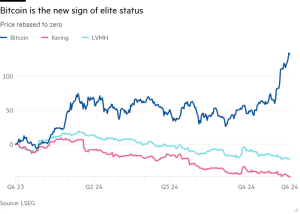Antimicrobial resistance is dangerous in more ways than one
Unlock the Editor’s Digest for free
Roula Khalaf, Editor of the FT, selects her favourite stories in this weekly newsletter.
The writer is a policy fellow at Center for Global Development. He was previously head of economic research on the O’Neill Review into Antimicrobial Resistance
When infectious diseases don’t have a cure, they can have a profound impact on the economy. Nothing highlighted this more clearly than Covid-19.
Fortunately, for the last 80 years, we have had a cure for bacterial infections in the form of antibiotics. But antimicrobial resistance (AMR) — where bacteria, fungi and viruses develop resistance to the drugs used to treat them — is rendering our arsenal of antibiotics ineffective.
In 2022, the first detailed analysis was published on the health burden of AMR. New follow up research from the University of Oxford and Institute for Health Metrics and Evaluation (IHME) estimates that between now and 2050, almost 39mn people will die from drug resistance.
Lesser known, but equally important, is the impact that AMR might have on our global economy. Previous research from Jim O’Neill’s Review into Antimicrobial Resistance and the World Bank highlighted risks to the economy. But a better understanding of the health burden has made it possible to carry out a much more accurate analysis of the economic impact of resistance.
In a new report on the economic repercussions of AMR, we found that the world spends an estimated $66bn annually treating people with a drug-resistant infection. If resistance is allowed to increase unimpeded this will then rise to $160bn in 2050 — 1.2 per cent of global health expenditure. In a similar vein, the global labour force will shrink more than 7mn if current antimicrobial resistance trends continue, as people are forced to leave the workforce due to deaths and illness. The biggest impact would occur in lower-middle-income countries.
For the first time we also have estimates on the impact of AMR on global tourism, which is projected to decline 2 per cent. Domestic hospitality, such as restaurant visits and “staycations”, would also suffer a decline of about half of this amount.
While this impact is small — particularly compared to Covid-19 — these sectors are still worth more than $20tn to the world economy. Even a small dent can have a huge impact, with poorer countries expected to be less able to withstand the economic consequences of resistance.
But the 39mn deaths from AMR between now and 2050 are not inevitable, nor is the economic disruption associated with them. We estimate that it would cost $63bn a year to fund a pipeline of new antibiotics and better treatment of bacterial infections across the world, which would include ensuring access to these life-saving drugs.
IHME estimates that this would save 100mn lives between now and 2050, the majority of which would be individuals with other non-resistant infections. This in turn would reduce annual health costs across the world by $97bn by 2050, meaning that in the long run, investing in new antibiotics now is ultimately cost saving for healthcare systems.
Improving access to and innovation of new antibiotics would also increase global GDP by $960bn by 2050. On top of this, there would be huge health gains, worth about $680bn if each year of good health is valued at each country’s GDP per capita — this is roughly what health systems usually judge as cost effective when deciding which treatments to fund. What’s more, we expect these gains to be largest in the world’s poorest countries, those hardest hit by AMR.
Put simply, investing in treatments and new drugs will save healthcare systems money in the long run, and offer a return of $28 for every dollar invested. Today, the world’s governments meet at the UN General Assembly in New York to discuss a new global declaration on AMR; whether driven by public health concerns or hard-headed financial decisions, the case for action is undeniable.
#Antimicrobial #resistance #dangerous #ways







